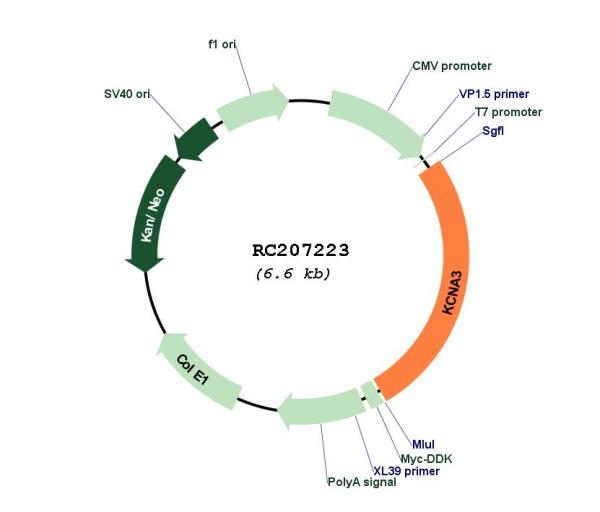KCNA3 (NM_002232) Human Tagged ORF Clone
CAT#: RC207223
KCNA3 (Myc-DDK-tagged)-Human potassium voltage-gated channel, shaker-related subfamily, member 3 (KCNA3)
ORF Plasmid: tGFP
Lentiviral Particles: DDK DDK w/ Puro mGFP mGFP w/ Puro
"NM_002232" in other vectors (7)
USD 198.00
Specifications
| Product Data | |
| Type | Human Tagged ORF Clone |
| Tag | Myc-DDK |
| Symbol | KCNA3 |
| Synonyms | HGK5; HLK3; HPCN3; HUKIII; KV1.3; MK3; PCN3 |
| Vector | pCMV6-Entry |
| E. coli Selection | Kanamycin (25 ug/mL) |
| Mammalian Cell Selection | Neomycin |
| Sequence Data |
>RC207223 representing NM_002232
Red=Cloning site Blue=ORF Green=Tags(s) TTTTGTAATACGACTCACTATAGGGCGGCCGGGAATTCGTCGACTGGATCCGGTACCGAGGAGATCTGCC GCCGCGATCGCC ATGGACGAGCGCCTCAGCCTTCTGCGCTCGCCGCCGCCGCCCTCAGCCCGCCACCGCGCCCACCCTCCTC AGCGCCCAGCGAGCAGCGGCGGTGCCCACACGCTGGTGAACCACGGCTACGCGGAGCCCGCCGCAGGCCG CGAGCTGCCGCCCGACATGACCGTGGTGCCCGGGGACCACCTGCTGGAGCCGGAGGTGGCCGATGGTGGA GGGGCCCCGCCTCAAGGCGGCTGTGGCGGCGGCGGCTGCGACCGCTACGAGCCGCTGCCGCCCTCACTGC CGGCCGCGGGCGAGCAGGACTGCTGCGGGGAGCGCGTGGTCATCAACATCTCCGGGCTGCGCTTCGAGAC GCAGCTGAAGACCCTTTGCCAGTTCCCCGAGACGCTGCTGGGCGACCCCAAGCGGCGCATGAGGTACTTC GACCCGCTCCGCAACGAGTACTTCTTCGACCGCAACCGGCCCAGCTTCGACGCCATCCTCTACTACTATC AGTCCGGGGGCCGCATCCGCCGGCCGGTCAACGTGCCCATCGACATTTTCTCCGAGGAGATCCGCTTCTA CCAGCTGGGCGAGGAGGCCATGGAGAAGTTCCGCGAGGACGAGGGCTTCCTGCGGGAGGAGGAGCGGCCC TTGCCCCGCCGCGACTTCCAGCGCCAGGTGTGGCTGCTCTTCGAGTACCCCGAGAGCTCCGGGCCGGCCC GGGGCATCGCCATCGTGTCCGTGCTGGTCATCCTCATCTCCATTGTCATCTTCTGCCTGGAGACGCTGCC GGAGTTCCGCGACGAGAAGGACTACCCCGCCTCGACGTCGCAGGACTCATTCGAAGCAGCCGGCAACAGC ACGTCGGGGTCCCGCGCAGGAGCCTCCAGCTTCTCCGATCCCTTCTTCGTGGTGGAGACGCTGTGCATCA TCTGGTTCTCCTTCGAACTGCTGGTGCGGTTCTTCGCTTGTCCTAGCAAAGCCACCTTCTCGCGAAACAT CATGAACCTGATCGACATTGTGGCCATCATTCCTTATTTTATCACTCTGGGTACAGAGCTGGCCGAACGA CAGGGCAATGGACAGCAGGCCATGTCTCTGGCCATCCTGAGGGTCATCCGCCTGGTAAGGGTCTTCCGCA TCTTCAAGCTGTCGCGCCACTCCAAGGGGCTGCAGATCCTCGGGCAAACGCTGAAGGCGTCCATGCGGGA GCTGGGATTGCTCATCTTCTTCCTCTTTATTGGGGTCATCCTTTTCTCCAGCGCGGTCTACTTTGCCGAG GCAGACGACCCCACTTCAGGTTTCAGCAGCATCCCGGATGCCTTCTGGTGGGCAGTGGTAACCATGACAA CAGTGGGTTACGGCGATATGCACCCAGTGACCATAGGGGGCAAGATTGTGGGATCTCTCTGTGCCATCGC CGGTGTCTTGACCATCGCATTGCCAGTTCCCGTGATTGTTTCCAACTTCAATTACTTCTACCACCGGGAG ACAGAAGGGGAAGAGCAATCCCAGTACATGCACGTGGGAAGTTGCCAGCACCTCTCCTCTTCAGCCGAGG AGCTCCGAAAAGCAAGGAGTAACTCGACTCTGAGTAAGTCGGAGTATATGGTGATCGAAGAGGGGGGTAT GAACCATAGCGCTTTCCCCCAGACCCCTTTCAAAACGGGCAATTCCACTGCCACCTGCACCACGAACAAT AATCCCAACTCTTGTGTCAACATCAAAAAGATATTCACCGATGTT ACGCGTACGCGGCCGCTCGAGCAGAAACTCATCTCAGAAGAGGATCTGGCAGCAAATGATATCCTGGATT ACAAGGATGACGACGATAAGGTTTAA >RC207223 representing NM_002232
Red=Cloning site Green=Tags(s) MDERLSLLRSPPPPSARHRAHPPQRPASSGGAHTLVNHGYAEPAAGRELPPDMTVVPGDHLLEPEVADGG GAPPQGGCGGGGCDRYEPLPPSLPAAGEQDCCGERVVINISGLRFETQLKTLCQFPETLLGDPKRRMRYF DPLRNEYFFDRNRPSFDAILYYYQSGGRIRRPVNVPIDIFSEEIRFYQLGEEAMEKFREDEGFLREEERP LPRRDFQRQVWLLFEYPESSGPARGIAIVSVLVILISIVIFCLETLPEFRDEKDYPASTSQDSFEAAGNS TSGSRAGASSFSDPFFVVETLCIIWFSFELLVRFFACPSKATFSRNIMNLIDIVAIIPYFITLGTELAER QGNGQQAMSLAILRVIRLVRVFRIFKLSRHSKGLQILGQTLKASMRELGLLIFFLFIGVILFSSAVYFAE ADDPTSGFSSIPDAFWWAVVTMTTVGYGDMHPVTIGGKIVGSLCAIAGVLTIALPVPVIVSNFNYFYHRE TEGEEQSQYMHVGSCQHLSSSAEELRKARSNSTLSKSEYMVIEEGGMNHSAFPQTPFKTGNSTATCTTNN NPNSCVNIKKIFTDV TRTRPLEQKLISEEDLAANDILDYKDDDDKV |
| Chromatograms |
CHROMATOGRAMS
 Sequencher program is needed, download here. |
| Restriction Sites |
SgfI-MluI
Cloning Scheme for this gene
Plasmid Map

|
| ACCN | NM_002232 |
| ORF Size | 1725 bp |
| OTI Disclaimer | Due to the inherent nature of this plasmid, standard methods to replicate additional amounts of DNA in E. coli are highly likely to result in mutations and/or rearrangements. Therefore, OriGene does not guarantee the capability to replicate this plasmid DNA. Additional amounts of DNA can be purchased from OriGene with batch-specific, full-sequence verification at a reduced cost. Please contact our customer care team at custsupport@origene.com or by calling 301.340.3188 option 3 for pricing and delivery. The molecular sequence of this clone aligns with the gene accession number as a point of reference only. However, individual transcript sequences of the same gene can differ through naturally occurring variations (e.g. polymorphisms), each with its own valid existence. This clone is substantially in agreement with the reference, but a complete review of all prevailing variants is recommended prior to use. More info |
| OTI Annotation | This clone was engineered to express the complete ORF with an expression tag. Expression varies depending on the nature of the gene. |
| Product Components | The ORF clone is ion-exchange column purified and shipped in a 2D barcoded Matrix tube containing 10ug of transfection-ready, dried plasmid DNA (reconstitute with 100 ul of water). |
| Reconstitution | 1. Centrifuge at 5,000xg for 5min. 2. Carefully open the tube and add 100ul of sterile water to dissolve the DNA. 3. Close the tube and incubate for 10 minutes at room temperature. 4. Briefly vortex the tube and then do a quick spin (less than 5000xg) to concentrate the liquid at the bottom. 5. Store the suspended plasmid at -20°C. The DNA is stable for at least one year from date of shipping when stored at -20°C. |
| Reference Data | |
| RefSeq | NM_002232.5 |
| RefSeq Size | 3346 bp |
| RefSeq ORF | 1728 bp |
| Locus ID | 3738 |
| UniProt ID | P22001 |
| Cytogenetics | 1p13.3 |
| Domains | BTB, K_tetra, ion_trans |
| Protein Families | Druggable Genome, Ion Channels: Potassium, Transmembrane |
| MW | 63.7 kDa |
| Gene Summary | Potassium channels represent the most complex class of voltage-gated ion channels from both functional and structural standpoints. Their diverse functions include regulating neurotransmitter release, heart rate, insulin secretion, neuronal excitability, epithelial electrolyte transport, smooth muscle contraction, and cell volume. Four sequence-related potassium channel genes - shaker, shaw, shab, and shal - have been identified in Drosophila, and each has been shown to have human homolog(s). This gene encodes a member of the potassium channel, voltage-gated, shaker-related subfamily. This member contains six membrane-spanning domains with a shaker-type repeat in the fourth segment. It belongs to the delayed rectifier class, members of which allow nerve cells to efficiently repolarize following an action potential. It plays an essential role in T-cell proliferation and activation. This gene appears to be intronless and it is clustered together with KCNA2 and KCNA10 genes on chromosome 1. [provided by RefSeq, Jul 2008] |
Documents
| Product Manuals |
| FAQs |
| SDS |
Resources
Other Versions
| SKU | Description | Size | Price |
|---|---|---|---|
| RC207223L1 | Lenti ORF clone of Human potassium voltage-gated channel, shaker-related subfamily, member 3 (KCNA3), Myc-DDK-tagged |
USD 1,103.00 |
|
| RC207223L2 | Lenti ORF clone of Human potassium voltage-gated channel, shaker-related subfamily, member 3 (KCNA3), mGFP tagged |
USD 1,103.00 |
|
| RC207223L3 | Lenti ORF clone of Human potassium voltage-gated channel, shaker-related subfamily, member 3 (KCNA3), Myc-DDK-tagged |
USD 1,103.00 |
|
| RC207223L4 | Lenti ORF clone of Human potassium voltage-gated channel, shaker-related subfamily, member 3 (KCNA3), mGFP tagged |
USD 1,103.00 |
|
| RG207223 | KCNA3 (tGFP-tagged) - Human potassium voltage-gated channel, shaker-related subfamily, member 3 (KCNA3) |
USD 1,003.00 |
|
| SC118765 | KCNA3 (untagged)-Human potassium voltage-gated channel, shaker-related subfamily, member 3 (KCNA3) |
USD 731.00 |
|
| SC317985 | KCNA3 (untagged)-Human potassium voltage-gated channel, shaker-related subfamily, member 3 (KCNA3) |
USD 804.00 |
{0} Product Review(s)
Be the first one to submit a review






























































































































































































































































 Germany
Germany
 Japan
Japan
 United Kingdom
United Kingdom
 China
China




